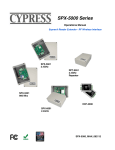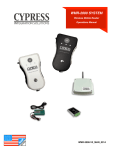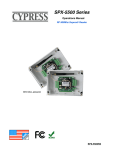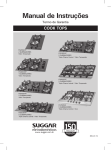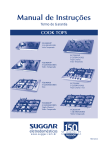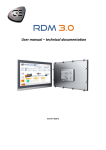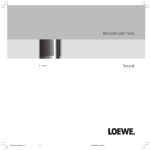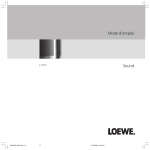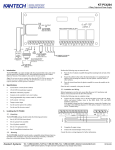Download Cypress Suprex WMR-9600MAN Specifications
Transcript
CYPRESS */5&(3"5*0/40-65*0/4 SPX-5601! 2.4GHz SPX-5521! 900 Mhz Suprex RF Series Operations Manual Suprex® Reader Extender RF Wireless Interface RPT-5651! 2.4GHz Repeater EXP-2000 SPX-5000_MAN_120113 1 of 17 ## Cypress Suprex SPX-5000 Series Overview This manual covers the operation and setup of the Cypress Suprex RF SPX-5000 series wireless units. # # Overview # :# The SPX-5000 series of RF Wireless solutions provides a wireless bridge from card readers with gates or door hardware to most access control manufacturers panels. The SPX or Suprex® products include both the remote ( Door/Gate ) unit and the central ( AC Panel ) unit. In the case of the SPX-5000 series of wireless products optional repeaters / extenders are also available.# # Features:! # -- Includes complete solution with remote ( reader/gate/door ) and central ( panel ) interface.# -- Service mode for setup and configuration.# --“Quiet” protocol to conserve bandwidth and power# -- Field configurable reader formats# -- Multifunction indicator for determining operational status of the unit# -- Auxiliary I/O connections available for Door/Gate/Panel status signaling. # -- Multiplexing of RF bridge providing for additional door/gate on a single RF link. # -- Economical expansion capabilities using Suprex Lynk technology# # RF Specifications:! # 2.4GHz or 900Mhz frequency# AES Encryption upon request Electrical and Mechanical Specifications Physical Temp Humidity Weatherproof Enclosure - ABS - IP65# SPX units 6.75” x 4.75” x 2.10” (Each unit) Storage(-55˚C to + 150˚C) - Operating(-40˚C to +80˚C) 95% (non-condensing) Input Unreg Input 8 to 16 VDC* @ 500mA Max # Unreg Input 8 to 24 VDC @ 500mA Max ( IOX-7000 ) Output +5VDC @100mA ( except IOX-7000 ) Interface Reader -Wiegand, Strobed (Clock & Data), F/2F# LED - 0 - 30V Power Data I/O (220Vdc 30W (resistive) 1A) Max Switching (250Vac 37.5VA 1A) Relays (30Vdc 1A (resistive), 1 x 105 operations at 20o C Running Spec with load 125Vac .3A (resistive), 1 x 105 operations at 20o C Cypress Computer Systems, Inc. ⌖ Lapeer, MI 48446 ⌖ www.cypresscomputer.com © 2012 Cypress Computer Systems Inc. 2 of 17 # Suprex® RF Part Numbers Part Number! Description! ! ! SPX-5521 915 Mhz - extender 10000 ft range RPT-5551 ! Interface ! UPC Wiegand or Clock & Data 816684003387 915 Mhz - repeater 1000 ft range N/A 816684003394 SPX-5601 2.4GHz - extender 2000 ft range Wiegand or Clock & Data 816684003219 SPX-5621 2.4GHz - extender 10000 ft range Wiegand or Clock & Data 816684003189 RPT-5651 2.4GHz - repeater 1000 ft range N/A 816684003172 80 55 Ambient Temperature (Degrees Celsius) 35 -40 8 10 12 14 16 Supply Voltage Temperature/Voltage de-rating curve The Suprex units should be operated with a filtered 12 Volt nominal DC supply. # Any voltage between 8 and 16 volts can be utilized by following the temperature /voltage derating curve. Voltage should not exceed 16 VDC under normal operating conditions. # 3 of 17 # # # # # # # # # # # # # # # External connections and DIP Switch Settings 1 - 8 to 16 VDC In # 2 - Ground 1- Relay 4 N.O.# 2- Relay 4 Com# 3 - Relay 4 N.C.# 4 - Relay 3 N.O.# 5 - Relay 3 Com# 6 - Relay 3 N.C.# 7 - Ground # 8 - Aux out# 9 - R2 in# 10 - R1 in Status LED 1 - exp (+)# 2 - exp (-)# 3 - +5 VDC out# 4 - Prog Res 4# 5 - Prog Res 3# 6 - LED In # 7 - D1/Data out # 8 - D0/Clk out SPX-5000! Central 1 - 8 to 16 VDC In # 2 - Ground Status LED 1 - exp (+)# 2 - exp (-)# 3 - +5 VDC out# 4 - R4# 5 - R3# 6 - LED out# 7 - D1/Data In # 8 - D0/Clk In Central Unit Settings DIP Switch #1 ON # -Service Mode# DIP Switch #1 OFF# -Run Mode # # # # 1 2 3 4 5 6 7 8 # # # # Dip switch #4 is ON -Disable Pullup resistors Dip switch #4 is OFF -Enable Pullup resistors Wiegand Wiegand / No Filter Strobed Rising Edge (MR-5) Strobed Rising Edge (Dorad0 644) Strobed Rising (Mag-Tek) Strobed Falling Edge Reserved F2F 4 of 17 Switch 6 7 8 0 1 2 3 4 5 6 7 x x x x x x x x x x x x # # SPX-5000! # Remote # # # # # # # # # # # # # # 1- Relay 2 N.O.# 2- Relay 2 Com# 3 - Relay 2 N.C.# 4 - Relay 1 N.O.# 5 - Relay 1 Com# 6 - Relay 1 N.C.# 7 - Ground # 8 - Aux in# 9 - Not used# 10 - Not used Remote Unit Settings DIP Switch #1 ON # -Service Mode# DIP Switch #1 OFF# -Run Mode 1 2 3 4 5 6 7 8 # # # # # x = ON # # # # # # Dip switch #4 is ON -Enable Pullup resistors Dip switch #4 is OFF -Disable Pullup resistors Wiegand Wiegand / No Filter Strobed Rising Edge (MR-5) Strobed Rising Edge (Dorad0 644) Strobed Rising (Mag-Tek) Strobed Falling Edge Reserved F2F 0 1 2 3 4 5 6 7 Switch 6 7 8 x x x x x x x x x x x x x = ON # # # # Central SPX-5000 Series # Quick Reference For Typical Connections # # # # # # DC# Power # Supply# +8 to +16 VDC# Ground Diagnostic LED # # # # # # # # # # # # # # # # # # # # # # # 5 of 17 R1 Input # Controls # Strike on# Remote Access! Control ! Panel! LED In# D1/Data Out# D0/Clock Out# R1 IN # # # See page 10 for other # #strike control options # # # # Remote SPX-5000 Series # DC# Power # Supply# +8 to +16 VDC# Ground Diagnostic LED R1 N.O.# R1 Com# R1 N.C. Card # Reader LED Out # D1/Data In# D0/Clock In # # # # # # # Door ! Strike ! Output # # Typical RF installation with repeater # ACS # # # # # # # SPX-5000C (1) ACS # # # # # # SPX-5000R (1) RPT-5X51 # # # # # Typical RF installation - line of sight # SPX-5000R (1) SPX-5000C (1) Typical RF installation - ! expansion modules EXP-2000R (2) EXP-2000R (3) SPX-5000C (1) SPX-5000R (1) ACS EXP-2000C (2) # # # Wiegand connection# Card reader # EXP-2000C (3) RS-485 multi-drop# Control and I/O 6 of 17 # Cable Recommendations! Belden or equivalent! # # # # # # SPX-1300, SPX-7500 and EXP-1000/2000! # RS-485 connection! # PVC - Belden 9744 - 22 AWG 2 twisted pair, 4,000 feet max.# Plenum - Belden 82741 - 22 AWG 2 twisted pair, 4,000 feet max.# # # # # SPX-1300, SPX-7200, SPX-7400/10, SPX-5601, SPX-5621, SPX-5521, WMR-7211, EXP-1000/2000! # Wiegand, power and LED! # PVC - Belden 9942 or 8777 - 22 AWG 3 pair shielded, 250 feet max.# Plenum - Belden 82777 - 22 AWG 3 pair shielded, 250 feet max.# PVC - Belden 9873 - 20 AWG 3 pair shielded, 500 feet max.# Plenum - Belden 83606 or 85164 - 20 AWG 3 pair shielded, 500 feet max.# # # Inputs/outputs! # PVC - Belden 8451 - 22 AWG 1 pair, 1,000 feet max.# Plenum - Belden 82761 - 22 AWG 1 pair, 1,000 feet max.# # # Power! # PVC - Belden 8461 - 18 AWG 1 pair, 25 feet max.# Plenum - Belden 82740 - 18 AWG 1 pair, 25 feet max.# # # 7 of 17 # # # # Cypress Suprex RF Series - Setup and Pre-installation Unpacking:! # # # Remove covers from units and check interior for any shipping damage. Remove any packing material if present.# Inventory any included parts (depending on model) such as antennas, coax cables etc.# Bench Testing:# Before installing the units in the field they should be assembled and tested at a convenient “Bench top” location. This will make it easier to verify / change settings and check operation when both units are visible at the same time. ! It is also a chance to become familiar with the system if this is the first time using the Suprex system. It is much more difficult to setup and test the units when they are several thousand feet apart.# Both units will need to have the antenna and a suitable power supply connected. For testing purposes, the units can share the same power supply.# During initial setup it is helpful to use the Setup/Config mode. This allows a relative indication of the radio link quality between the units. # # # # SEE ADDENDUM FOR ADDITIONAL PROGRAMMING AND DIAGNOSTICS ! Basic Bench Test:! 1. Connect any antennas if the unit was shipped without antennas installed.# 2. Connect a suitable power supply to both units. Each unit should be provided with 8 - 16 volts DC and approx 300mA. Both units should be separated by a minimum of 24 inches.# 3. Apply power. After about a 1 -2 second delay both units Diagnostic LED should indicate Green.# 4. Touch a jumper wire from the Ground connection the the Relay 1 input on the Central unit. Relay #1 on the Remote unit should activate with an audible click and the Diagnostic LEDs should flash green on both the Central and Remote units.# 5. Units are shipped from the factory set for the Wiegand data format. If a different format is required set the DIP switch to the required reader and panel format. # 6. If a reader and panel is accessible, connect the reader to the Remote unit and the Central unit to the panel and verify that card reads are being accepted by the access control system. If any troubleshooting is necessary, it will be easier to do with both units in close proximity to each other. # 7. Once these steps are completed, the units are ready for installation it their permanent locations and final commissioning as a system. Antenna orientation and field placement:! # # # See examples below for RF units with dipole antennae and “chip” antennae. The orientation of the dipole antennae is critical for performance. The antennae should always be oriented vertically. Orientation of RF units with integral “chip” antennae is not as critical.# Radio frequencies in the 900 MHz and 2.4 GHz bands have characteristics that require LOS “Line of sight” between the transmitter and receiver. For best performance the antennas of the Central and Remote should “see” each other without obstructions.# There are limited exceptions where the signal will still pass between the transmitter and receiver without line of sight placement. In some cases, the communication path will work but at a reduced distance.# # When possible, for outdoor installations place the units on the exterior of buildings to reduce interference. Repeaters/ Boosters are available if needed. Dipole antenna example 8 of 17 Chip antenna example # # # # # # # # # # # # # # # # # # # # # # # # # # # # # # # # # # # # # # # # # # # # # # # # # # # Cypress Suprex RF Series - Indicators and Operating Modes LED Diagnostic Indicator:# # # # The LED Diagnostic indicator provides information on the operational status of the unit.# If the units are not communicating, viewing the diagnostic indicator LED’s may help to determine the # nature of the problem.# When the Suprex units are operating correctly and have a valid communication channel between# the Remote and Central units, the Diagnostic indicators on each unit will flash green rapidly # (2-3 flashed per second) in Service / Config mode and illuminate a steady green in quiet mode.# ## # # # # # # # # # # # # DIAGNOSTIC LED NOT ILLUMINATED:# If the LED(s) are not illuminated on the unit(s) then the unit is not getting power or there is an electrical problem. The Diagnostic LED’s will be illuminated Red/Green or flashing whenever power is applied.# CENTRAL UNIT FLASHING BETWEEN RED/GREEN:# With power applied and no communication path between the Remote and Central, the Central unit will flash the diagnostic indicator alternately between Red and Green.# REMOTE UNIT ILLUMINATED RED:# The Remote unit will diagnostic LED will illuminate solid (not flashing) red if it is not receiving communication from the Central.# REMOTE AND CENTRAL UNITS FLASHING BETWEEN RED/GREEN:# The Central is not Receiving communication from the Remote.# Operating modes:# By setting DIP switch 1 to the ON position, the unit is placed in Setup / Config mode. When the switch position is changed, cycle power to the unit to make the switch change take effect.# In "Quiet" mode (DIP switch #1 OFF) the units will remain quiet unless there is a status change, and will slowly poll each other about every 10 to 15 seconds to check the link integrity. # The Setup / Config mode places the units in a rapid polling sequence to allow troubleshooting and setup of the communication link. # The Suprex RF units use a quiet protocol when operating in Quiet mode. Communication between the Central and Remote unit only occurs when an event requires data transmission or contact needs to be made to maintain supervision. The RF channel remains quiet most of the time.# # During setup or troubleshooting it may be necessary to observe the communication link between the Central and Remote units. The rapid polling used in the Setup / Config mode can help indicate whether the units can “See” each other. Additionally the Central unit Diagnostic LED will indicate Red when communication is lost.# # In some cases an optimal mounting location can be selected by operating one of the units on a small 12 volt battery and moving the location while observing the diagnostic LED indicators. 9 of 17 # # Cypress Suprex RF Series - # Door Strike and LED I/O # # # # # # # # # # # # # # # # # # # # # # # # # # # # # # # # # # # # To activate the relay on the Remote unit, connect as shown below. These connections can be used to allow the Remote relay to operate a DOOR STRIKE, GATE, or other locking hardware. Refer to following pages in this document for details of each I/O operation and connection.# # There are two relays available for accessory outputs at the Remote end. Either relay can be used to provide the Door Strike or Gate activation function. This example uses Relay 1. Wiring Example - Door Strike Follows LED Ground Suprex RF Central Ground Access! Control ! Panel LED Signal LED In R1 Input # Controls # Strike on# Remote R1 IN Only Relay and LED Connections are shown for clarity, refer to previous diagrams for Power and Data connections. Wiring Example - Door Strike does not follow LED Ground Suprex RF Central Access! Control ! Panel Ground Ground LED Signal N.O. Com Strike Signal Ground 10 of 17 LED In R1 Input # R1 IN Controls # Strike on# Remote # Cypress Suprex RF Series - Door Strike and LED I/O The Cypress SPX-5000 provides additional data channels to support access control hardware such as door strikes, tamper alarms, request to exit status, etc. These signals are sent to and from the Remote and Central units without the need to run additional wiring.# # The accessory control I/O use active low inputs. When the inputs are floating (nothing connected) the associated output will be set to a high level. When the input is set to 0Volts (Ground) the input will activate its associated output. All Accessory outputs are Open Collector type and will switch to Ground when activated.# # Each input will have an associated output. See the following pages for a diagram of each I/O pair.Inputs can be tested by making a jumper connection to ground and monitoring the associated output. Suprex RF Central Ground Jumper to ground to test LED In Input Red arrow denotes direction of command signal Suprex RF Remote LED Out Output 11 of 17 # Cypress Suprex RF Series - Relay Controls Relay 4 N.O# Relay 4 Com# Relay 4 N.C. Suprex Central Relay 3 N.O.# Relay 3 Com# Relay 3 N.C. Suprex Central Contact Outputs Contact Outputs Red arrow denotes direction of command signal Suprex Remote Suprex Remote Relay 4 IN Relay 3 IN Input Signal (5Volts DC Maximum) Input Signal (5Volts DC Maximum) Relay 3 functions as an Alarm relay and monitors the condition of the communication link between # the Central and Remote units. Relay 3 is activated when power is applied and the communication link between the Central and Remote is functioning. Relay 3 will become deactivated (Alarm condition)# when either the Relay 3 input on the remote is active OR the Remote unit is unable to communicate with the Central unit. See APP NOTE FOR DETAILS 12 of 17 Cypress Suprex® RF Series - Relay Controls # Suprex® Central Suprex® Central Relay 2 IN Input Signal Relay 1 IN Input Signal Red arrow denotes direction of command signal Relay 2 N.O.# Relay 2 Com# Relay 2 N.C. Suprex® Remote Contact Outputs Relay 1 N.O.# Relay 1 Com# Relay 1 N.C. Suprex® Remote Contact Outputs 13 of 17 SPX-XXXX Application Note # Using Supervised Contacts with the SPX-series Extenders # Applies to the following products: SPX-5501, SPX-5601, SPX-5521, SPX-5621, SPX-7400, SPX-7410, SPX-7200, SPX-7500, All RIM series products. # This application note describes the connections necessary to convey supervised contact status over a Suprex® communication link. The configurations described in this app note should apply to most panels that utilize supervised contacts. When connected as described, the Suprex® system will provide a supervised signal to the panel interface by reading the supervised status of the contacts connected to the Suprex® Remote unit. # Theory of operation: The Access control panel is looking for a certain value of resistance connected to the supervised contact terminals. The Suprex® Central unit will provide these resistance values locally at the panel so that the correct supervised status is maintained. At the same time, the Remote unit must maintain supervision of the wires connected to the relays and switches that are connected to the remote access point. The contact supervision is provided by the Remote unit. The Suprex® system does this by comparing the value of programming resistor at the Central unit with the resistance seen at the Remote interface terminals. When there is a difference in the two values, the Relay on the Central unit is activated. There are two different examples. One example is monitoring a normally closed contact at the Remote unit, and the other example is monitoring a normally open contact at the Remote unit. In the examples given, a normally closed contact will require a programming resistor of 1K and a normally open contact will require a programming resistor of 2K. Other resistor values can be used but 1K resistors are the most common. Other resistance values will require different value(s) for the programming resistor(s). # 8 to 16 VDC In # Ground Diagnostic LED 2K 1K exp (+)# exp (-)# +5 VDC out# Prog Res 4# Prog Res 3# LED In # D1/Data out # D0/Clk out Central Unit I1- Relay 4 N.O.# Relay 4 Com# Relay 4 N.C.# Relay 3 N.O.# Relay 3 Com# Relay 3 N.C.# Ground # Aux out# R2 in# R1 in 8 to 16 VDC In # Ground Door N.C. Contact Rex N.O. Contact 14 of 17 Diagnostic LED 1K 1K 1K 1K exp (+)# exp (-)# +5 VDC out# R4# R3# LED out# D1/Data In # D0/Clk In Remote Unit 1K 1K Relay 2 N.O.# Relay 2 Com# Relay 2 N.C.# Relay 1 N.O.# Relay 1 Com# Relay 1 N.C.# Ground # Aux in# Not used# Not used I1+ I2I2+ SPX-5000 Setup - Using Expansion Modules Before using EXP-2000 Expansion modules with the SPX-5000 system, it will be necessary to perform a short configuration process. This process determines if the 5000 will utilize expansion modules, and if so, how many will be used with the system. Each SPX-5000 link can support up to 2 expansion modules. # # # # # # SPX-5000 units are shipped in the factory default condition. Factory default units will be setup to function as SPX-5000 units without expansion modules. Only communications between the 2 gateway units will be active. # Setup Process:# 1. With power off, set the DIP switch on the Central unit according to the table below.# 2. Apply power.# The Diagnostic LED should display a steady Green indication.# 3. Remove power# Set DIP switch #1 OFF. Any other DIP switches can now be set as required (Reader family/ Pullup resistors).# The Central unit is now configured. No expansion module configuration is required for the Remote unit.# # # # # 4. The expansion modules will need to be setup and correctly addressed. See EXP-2000 manual for details of # Expansion module setup and configuration. The Expansion units are addressed, and added to the system as pairs.# 5. Connect the Expansion modules into the system as indicated in this wiring diagram.# Operation with Expansion Modules:# The SPX-5000 system Remote and Central gateway units will operate as a standard pair Suprex units, all of the I/O and data terminals are available for use with readers and access control systems. There are some minor differences in operation when using the expansion modules. Wiegand protocol only. # # # # 1. The Diagnostic LED on the Gateway units will indicate the status of the main (gateway) communication link only.# 2. The Alarm relay on the Central Gateway unit will deactivate (indicate alarm condition) when the communication fails between the Gateway units or ANY of the the Remote or Central Expansion units.# 3. Paired Expansion units will be functionally similar to the standard Cypress SPX-1300 Suprex® system.# # Central Unit Configuration Mode Settings # # # # # # # # # # Switch# 1 2 3 4 5 6 7 8# Gateway only - No EXP# 1 1 1 1 0 0 0 0# 1 EXP Pair used # # 1 1 1 1 0 0 0 1# 2 EXP Pair used# # 1 1 1 1 0 0 1 0# 1 2 3 4 5 6 7 8 # 1 = ON# 0 = OFF See EXP-2000 Manual for further setup instructions 15 of 17 Cypress Suprex Series - Wiegand Expansion Module! Panel “Central” interface DC# Power # Supply +8 to +16 VDC# Ground EXP(+)# EXP(-)# # # # Access! Control ! Panel LED In D1/Data Out# D0/Clock Out 8 to 16 VDC In# Ground 485(+)# 485(-)# +5 VDC Out# Prog Res 4# Prog Res 3# LED Input# D1 Wiegand # D0 Wiegand * 16 of 17 SPX-XXXX ! Central EXP-2000! Central Unit R1 Input # Controls # Strike on# Remote R1 IN RLY4 N.O.# RLY4 Com# RLY4 N.C.# RLY3 N.O.# RLY3 Com# RLY3 N.C.# RS232 Out# RS232 In# Ground# Aux Out# Relay2 Input# Relay1 Input Cypress Suprex Series - Wiegand Expansion Module! Reader/Door “Remote” interface DC# Power # Supply 8 to 16 VDC In# Ground EXP (+)# EXP (-)# # # # SPX-XXXX ! Remote R1 N.O.# R1 Com# R1 N.C. LED Out# D1/Data In D0/Clock In Card # Reader 8 to 16 VDC In# Ground 485(+)# 485(-)# +5 VDC Out# RLY4 Input (5V)# RLY3 Input (5V)# LED Output# D1/Wiegand# D0 Wiegand * EXP-2000! Remote Unit RLY2 N.O.# RLY2 Com# RLY2 N.C.# RLY1 N.O.# RLY1 Com# RLY1 N.C.# RS232 Out# RS232 In# Ground# Aux In# N/C# N/C See EXP-2000 Manual for further setup instructions 17 of 17 Door ! Strike ! Output

















